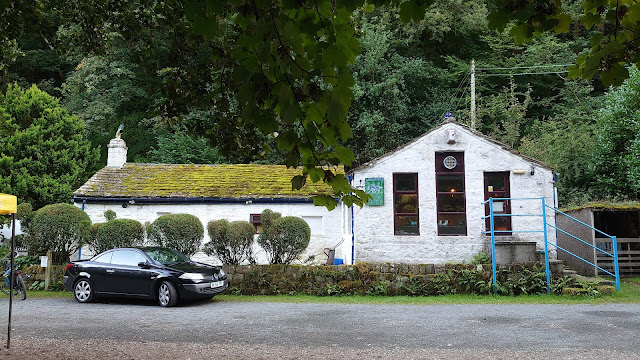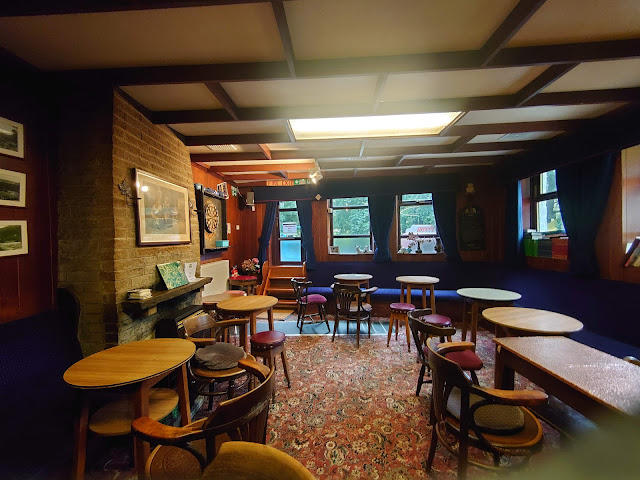I faced another weekend where circumstances beyond my control brought about a change of plan. This week, instead of watching football on Saturday afternoon, I disappeared into a lovely, wooded valley just outside Hebden Bridge in order to visit a small beer festival at a unique institution....
Early last Friday morning, I received a reply to an unanswered message I had sent to my mate John earlier in the week, to be shortly followed by another from him saying he was thinking of going along on Saturday to a beer festival being held at the Midgehole Working Men's Club, a couple of miles outside Hebden Bridge, and did I fancy it? I said I would let him know as at that point I was planning to attend the National League game between Halifax Town and Dorking Wanderers at the Shay, with Town seeking their first home win in what has been a troubled start to the season. However, shortly afterwards news broke that all football from the Premier League down to the grassroots had been cancelled in response to the week's events. I contacted John and said I would join him, glad to have an alternative to the football crop up at such an opportune time!
We arranged to meet at Halifax Railway Station on the Saturday to catch the 1428 to Hebden Bridge, which was on time and quite busy with shoppers, walkers, and would-be revellers no doubt bound for Manchester. We alighted and took the towpath route into town. The streets in the centre were thronging with day trippers and shoppers, but within a few minutes we were through it, passing factories abandoned for the weekend and quiet, solid stone terraced houses. We crossed an ancient packhorse bridge over the river Hebden, which was on its way to merge with the Calder a few hundred yards away, then took a narrow footpath following the river upstream as we walked through increasingly wooded countryside. We passed a cricket field where an impromptu game was taking place, an old man who appeared to be collecting logs, and finally a bowling green, hemmed in against the tight slopes of the wooded hillside.
We walked on beside the river for a few more minutes before following the path as it started to climb up the hillside. We headed away from the river and as we walked up a track, passing fields, views of the hills beyond appeared. We joined a tarmac road leading to couple of houses and carried along at that level for a few minutes, before our last ascent of this leg of the journey, up a set of ancient stone steps to another level path, high above the river below. Soon we began our descent via a steep and ancient, pretty worn, packhorse route emerging shortly afterwards at the outside of Midgehole Working Men's Club, aka The Blue Pig.
The club is in a single storey stone building with thick, white-painted walls which seems to have sprung up from the land on which it lies. It is in an idyllic setting, with the river Hebden gurgling past beyond a partly tarmac, partly gravelled area in front of the building. Beyond there are a few cottages and close by is the National Trust car park for Hardcastle Crags, but thousands of the visitors who come to this area will pass by, completely oblivious to its presence. This peaceful scene belies the fact that at one time there were several mills in the valley, with the combination of the sheep that roamed the surrounding hills and the soft waters of the river enabling the processing and dyeing of wool.
 |
| The Blue Pig, Midgehole, near Hebden Bridge |
We arrived to find several groups of people sat outside with drinks, whilst across the car park a van was selling food. A sign at the entrance was advertising the festival beers at £2.50 a pint plus £2.00 entry for non-members which still worked out at a very reasonable £2.90, based on a quantity of 5 pints purchased! There were 8 beers on especially for the beer festival, served from the barrel on racking set up against the wall in the small room that contains the bar, which had a further 3 beers on hand pump: Taylors' Landlord, Goose Eye Chinook, and Butcome Gold. The festival beers meanwhile included Brother Rabbit from Thornbridge, Devils IPA from Kirby Lonsdale Brewery, Saltaire Cascade, and Elland 1872 Porter.
We both opted for halves of Brother Rabbit to kick off proceedings and went to sit in the larger room off the bar which featured much wood panelling and pictures and signs from years gone by. There was a dartboard at one end of the room, and curtains allowing the room to be closed off from the bar when meetings or other events are taking place. Despite the traditional scene the room was quite light and airy, with several windows affording views of the bucolic scene outside. It was quiet when we went in there, but gradually started to get more people in as the afternoon merged into evening. We meanwhile availed ourselves of all but one of the beers, and I have to say all of them were in excellent condition. A couple of club stalwarts, Paul and Steve, who were also working at the festival came and sat down at a neighbouring table and began chatting to us. A couple sat at another table asked about the origins of the club. Paul said the club had originally opened around 1910 thus making it one of the oldest in the country. It is entirely run by volunteers and is CIU-affiliated. Membership costs £10 a year, the number capped at 450, which seems amazing for such a small and out of the way place. But then again, you sense it is a special place, somewhere quite different, quite timeless, which gives it quite some appeal. And where did the name come from? Various theories exist but one, which would be great if it were true suggests that after one of the textile mills that used to exist in the area had had a spillage of dye into the river, a pig fell in, eventually emerging from it a distinctive shade of blue.
John and I tried halves of all the beers that had been brought in for the festival apart from the Lunar from Half Moon, and I have to say every beer was spot on in its own way. It was very hard to pick a standout, but I have to say I thoroughly enjoyed the half of 1872 Porter that concluded the evening's proceedings here. Our tokens were spent, the food van had done one, so we decided to head back to the bright lights of Hebden Bridge for a bite to eat. It was great to visit here again, the last time I had walked past was a couple of years ago after the first Covid lockdown when social distancing and table service were the norm, and the sign outside said it was members only so we couldn't call in. My only other visit had been a year or two before the pandemic when some friends and I called in having been for a walk on the hills above. It didn't seem to have changed at all since then. The Blue Pig has limited opening hours, but if you get chance to call it is a fascinating place, very much steeped in the history of the area. You don't have to walk there either; there is a bus that runs to Midgehole from Hebden Bridge although its times are limited, so plan your visit in advance.
We emerged from the club as the sun was beginning to go down. It was quiet as we crossed over the bridge and passed a row of attractive cottages, not following the same route back to Hebden we had arrived by but going via the road on the other side of the narrow valley. At a cottage on the right, we turned right down a gently sloping ramp which ran almost parallel to the road for a short distance, before turning right down some steps and then almost immediately turning right over a bridge, and then left to join the path we had walked up on our way there, and back to the town.
As we walked, we got talking to the couple who had been at The Blue Pig, who lived in Hebden Bridge. The conversation got on to places to eat in the town and they gave us one or two recommendations. They headed off back home as we hit Hebden, and we decided to take them up on their suggestion of an Indian restaurant, Cardomom, which we soon found, sandwiched between Coin and the Albert. The place wasn't too busy, and other than the rather dim light which made reading the menu a little difficult, I couldn't really fault this stylish restaurant which had some atmospheric large black and white prints of the area on the walls. The food was very good, washed down with the obligatory pint of Cobra, and pretty good value for money. I would happily go there again.
We had enough time before our train to pop around the corner to Vocation & Co for a final beer. It was something of a shock after all this time to see 4 hand pumps on the bar. Ever since the bar opened, cask beers had been served from taps on the back wall of the bar along with the much larger keg range, but it makes sense, as I am sure the average cask drinker would prefer the reassurance their presence gives that cask is an important part of the bar's offer. Despite that, we both opted for a keg beer as a contrast after a day sampling cask beer from the barrel. I had two-thirds of Crush Hour, a 4.6% juicy hazy pale which I thought could have been Hop, Skip, and Juice's cheeky little brother.
It had been an excellent day out and thanks to John for suggesting it. We'd had a pleasant walk in some beautiful countryside, visited a fascinating club, drunk some excellent beer, met some interesting people, and finished it all off with a decent curry. The fact it only came about because there was no football had soon been forgotten....
Follow me on twitter: @realalemusic







Comments
Post a Comment